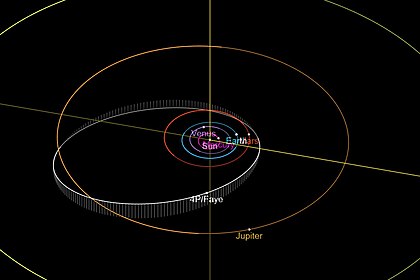 | |
| Discovery | |
|---|---|
| Discovered by | Hervé Faye |
| Discovery date | November 23, 1843 |
| Designations | |
| P/1843 W1, P/1850 W1, 1910e | |
| Orbital characteristics | |
| Epoch | 2021-09-23[1] (JD 2459480.5) |
| Aphelion | 6.03 AU[1] |
| Perihelion | 1.619 AU |
| Semi-major axis | 3.824 AU |
| Eccentricity | 0.5767 |
| Orbital period | 7.48 a |
| Inclination | 8.013° |
| Last perihelion | 2021-Sep-08[1] May 29, 2014 November 15, 2006 |
| Next perihelion | 2029-Mar-09[2] (JPL Horizons) |
| TJupiter | 2.737 |
| Earth MOID | 0.56 AU (84 million km) |
| Physical characteristics | |
| Dimensions | 3.54 km[3] |
| Perihelion distance at different epochs[4] | |||||||
| Epoch | Perihelion (AU) | ||||||
|---|---|---|---|---|---|---|---|
| 1806 | 1.74 | ||||||
| 1843 | 1.69 | ||||||
| 1984 | 1.59 | ||||||
| 2102 | 1.51 | ||||||
Comet 4P/Faye (also known as Faye's Comet or Comet Faye) is a periodic Jupiter-family comet discovered in November 1843 by Hervé Faye at the Royal Observatory in Paris. Its most recent perihelia (closest approaches to the Sun) were on November 15, 2006; May 29, 2014;[5] and September 8, 2021.[1]
The comet was first observed by Faye on November 23, but bad weather prevented its confirmation until the 25th.[6] It was so faint that it had already passed perihelion about a month before its discovery, and only a close pass by the Earth had made it bright enough for discovery. Otto Wilhelm von Struve reported that the comet was visible to the naked eye at the end of November.[6] It remained visible for smaller telescopes until January 10, 1844, and was finally lost to larger telescopes on April 10, 1844.[6]
In 1844, Friedrich Wilhelm Argelander[7] and Thomas James Henderson[8] independently computed that the comet was a short-period comet; by May, its period had been calculated to be 7.43 years.[6] Urbain Le Verrier computed the positions for the 1851 apparition, predicting perihelion in April 1851.[6] The comet was found close to his predicted position on November 29, 1850, by James Challis.[6]
The comet was missed during its apparitions in 1903 and 1918 due to unfavorable observing circumstances.[6] It reached a brightness of about 9th magnitude in 2006.[9]
4P/Faye has a close approach to Jupiter every 59.3 years, which is gradually reducing its perihelion and increasing its orbital eccentricity. In the most recent close approach to Jupiter (March 2018), Faye's perihelion changed from about 1.7 AU to about 1.5 AU.[10]
The comet nucleus is estimated to be about 3.5 km in diameter.[11]
- Orbit of Comet 4P/Faye.
- ^ a b c d Cite error: The named reference
mpcwas invoked but never defined (see the help page). - ^ Cite error: The named reference
Horizons2029was invoked but never defined (see the help page). - ^ Cite error: The named reference
jpldatawas invoked but never defined (see the help page). - ^ Cite error: The named reference
Kinoshitawas invoked but never defined (see the help page). - ^ Cite error: The named reference
NK2145was invoked but never defined (see the help page). - ^ a b c d e f g Cite error: The named reference
kronkwas invoked but never defined (see the help page). - ^ Argelander, Friedrich W.A. (January 3, 1844). "Schreiben des Herrn Professors Argelander, Directors der Sternwarte in Bonn, an den Herausgeber". Astronomische Nachrichten. 21 (495): 225–226. Bibcode:1844AN.....21..225A. doi:10.1002/asna.18440211502.
- ^ Henderson, Thomas J. (January 10, 1844). "On the Orbit of the Comet of Faye". Monthly Notices of the Royal Astronomical Society. 6 (3): 18–20. doi:10.1093/mnras/6.3.18b.
- ^ Cite error: The named reference
Yoshida-2006was invoked but never defined (see the help page). - ^ "Comet of the month – 4P/Faye | British Astronomical Association".
- ^ Lamy, P. L.; Toth, I.; Weaver, H. A.; A'Hearn, M. F.; Jorda, L. (December 2009). "Properties of the nuclei and comae of 13 ecliptic comets from Hubble Space Telescope snapshot observations". Astronomy & Astrophysics. 508 (2): 1045–1056. Bibcode:2009A&A...508.1045L. doi:10.1051/0004-6361/200811462. S2CID 125249770.
